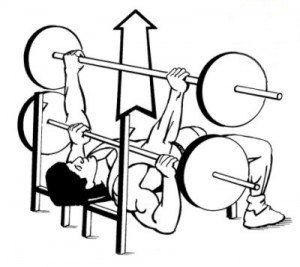Myth: Strength Training is Not Specific to Baseball Pitching

This myth has been perpetuated throughout baseball, from the lowest to the highest levels and all around the world. Frankly, it’s a load of BS. It’s very simple to understand without getting too deep into the physics of the movement, so we’ll keep it short.
You can find no shortage of papers that cite that elbow valgus stress in the pitching motion can exceed 60 Newton-meters (Medscape), which is higher than the theoretical maximum loading ability of the UCL in cadaver-based studies. But what exactly does 60 Newton-meters mean? Well, 60 Newton-meters is roughly equivalent to 81.35 pound-feet of torque. One foot-pound force is equivalent to one pound of force acting at a perpendicular distance of one foot from a pivot point. So, if you moved a one pound object exactly one foot in the air perpendicular to the force, that qualifies. A simple example is the bench press:
It’s not perfect, since no lifter moves the bar exactly perpendicular to the body, but it’s close.
Critics often say that the bench press doesn’t contribute to release velocity or injury prevention because a baseball weighs 5 ounces while a bench press is far greater. The truth, of course, is that the actual weight does not matter. Your body doesn’t care if an object weighs 5 ounces or 200 pounds – it cares what the raw force acting upon the body is!
Since we know that releasing a baseball can create up to (or even exceed) 81.35 pound-feet of torque, let’s do some simple math to see how much force a 135 lb. bench press creates. Keeping it very simple, let’s assume that the bench press moves 12 inches in the concentric direction roughly perpendicular to the action of force. This would mean that a single rep of the bench produces 135 pound-feet of torque per concentric repetition!
Consider that the higher values in the bench press do not exactly mimic the force the elbow undergoes, since more muscle groups are involved in the bench press. Think about which large muscle groups in the shoulder/arm are firing to create release velocity – not many! Therefore, the muscles in the shoulder/elbow undergo a proportionally higher load than the larger muscle groups in the bench press – or squat, deadlift, barbell row, or any other weight room exercise.
The myth that strength training is useless because the baseball only weighs 5 ounces is nothing short of stupid. The load per contracting muscle fiber that the elbow/shoulder experience far exceeds the amount of force that average lifters will experience in their compound movements.
Strength training plays a large part in keeping a baseball pitcher healthy and helping to improve his release velocity. By strengthening the segments that sequence together to throw a ball hard (largest to smallest, proximal to distal), pitchers can increase their fastball velocity. And by strengthening the decelerators, pitchers can safely do so as well.
Train for strength. Don’t listen to the people left behind in the 1960’s. Train at Driveline Baseball.
Comment section